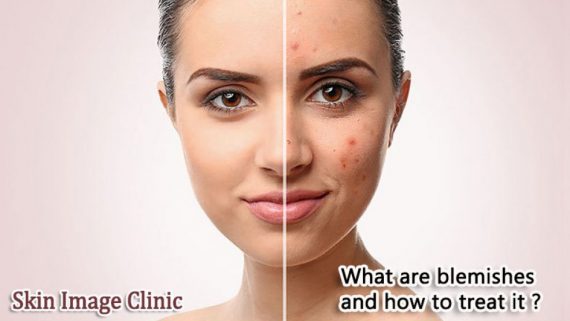What are blemishes?
A blemish is any type of mark, spot, discoloration, or flaw that appears on the skin. Blemishes on the face may be unsightly and emotionally upsetting, but most are benign and not life-threatening. Some blemishes, however, can signal skin cancer. Contacting dermatologist for medical treatment or using at-home remedies may help reduce the appearance of blemishes.
Types of blemishes
“Blemish” is a broad term that refers to any type of skin mark. There are numerous types of blemishes.
1) Acne: Acne is caused when sebum (oil), bacteria, or dirt clogs hair follicles. Acne can sometimes leave dark spots, pockmarks, or scarring on the skin. These are also types of blemishes. Hormonal changes are thought to play a role in the formation of acne. Stress may also make acne worse by increasing sebum production, although it’s not considered to be a root cause of this condition.
2) Papules: Papules are small skin lesions of varying types. They’re typically around 1 centimeter in diameter. They can range in color from pink and to brown. Pimples are sometimes referred to as papules. Papules can occur individually or in clusters and can be any shape Examples of papules include:
- chickenpox rashes
- eczema
3) Dermatitis Nodules: Nodules are a collection of tissue. They’re hard to the touch larger than papules, usually 1 to 2 centimeters in diameter. Nodules can occur at any level of the skin. They can vary in color from flesh-toned to red. Skin tags and warts are examples of nodules. Age spots (liver spots) : These small, dark spots can form on any area of the body that’s been exposed to the sun. They’re most common in people over 50, but they can also occur in younger people.
4) Pustules: Pustules are fluid- or pus-filled bumps. Whiteheads and chickenpox blisters are types of pustules. Other conditions that might cause pustules to form include scabies and rosacea, a common skin condition marked by blisters and visible blood vessels.
5) Birthmarks: Birthmarks typically occur either at birth or shortly afterward. They can range in appearance, size, shape, and color. Moles and port-wine stains are types of birthmarks that typically last for life. Other types, such as hemangioms and salmon patches, tend to fade over time.
6) Melasma: it is very common during pregnancy. It’s a skin condition identified by brownish patches. It can be brought about by sun exposure and hormonal changes.
7) Skin cancer: There are several types of skin cancers, including:
- Basal cell carcinoma
- Squamous cell carcinoma
- Malignant melanoma
Skin cancers can range in appearance and in color. Some forms of skin cancer look like dark moles
with irregular borders. Others look like yellow scabs or raised red bumps. Only your doctor can tell for sure if a blemish is skin cancer.
8) Cysts: There are several different types of cysts. They include:
- Epidermoid cysts
- Ganglion cysts
- Sebaceous cysts
Cysts are benign (noncancerous) sacs that contain a substance, such as fluid. They may appear as bumps of varying sizes on or under the skin. They’re often round.
9) Scars: Scarring of the skin occurs when the dermis layer becomes damaged. The dermis is the deep layer of skin where small blood vessels (capillaries), sweat glands, hair follicles, and nerve endings are located. Anything that causes the skin to open can lead to scarring, such as a wound or popped pimples.
What causes blemishes?
Sensitivity to hormones and the combination of surface skin bacteria and lipids (fatty acids) within sebaceous (oil) glands leads to acne. Acne often starts as a clogged pore and progresses to papules and pustules (small bumps) once bacteria spreads. Blemishes can also be caused by the development of fungal acne.
Viruses: Some blemishes, like cold sores, are caused by viruses, such as HSV-1. The varicella-zoster virus (VZV) causes chickenpox.
Infections: Certain types of skin infections can cause blemishes to erupt on the skin. These include malassezia folliculitis (fungal acne), an infection in the hair follicles. This condition is caused by an overgrowth of yeast and causes pustules to form.
Genetics: Acne may have a genetic link. Certain hereditary conditions can also cause blemishes to occur.
Sun exposure: Overexposure to the sun’s harmful ultraviolet (UV) A and B rays can cause skin cancer, hyper pigmentation, and other forms of skin damage.
Clogged pores: An overproduction of oil by the sebaceous glands can cause blemishes. Hormonal changes often trigger this overproduction, such as puberty. Excess oil can mingle with dead skin cells, dirt, or bacteria. This results in pimples, pustules, blackheads, and whiteheads to form.
Diet: What you eat might have an impact on your skin. Food allergies and contact dermatitis can both cause skin irritation and bumps. Dairy products, such as skim milk, may cause acne. Trusted source in some people. Diets high in sugar and simple carbohydrates may also lead to blemishes.
How to take care of blemished skin:
- Grab a facial scrub
- Use products with benzyl peroxide
- Give your skin care regimen time
- Book an appointment with your dermatologist
You can visit to your
dermatologist. Your dermatologist will be able to explore the cause of your blemishes and give you advice on products and treatments that may be able to help clear your skin.
Skin Image clinic, Faridabad provides treatment and care related to blemishes. You may contact and book a prior appointment for better care.


Leave a Reply